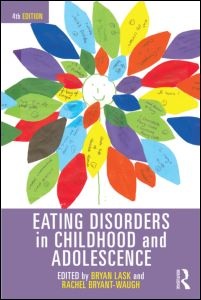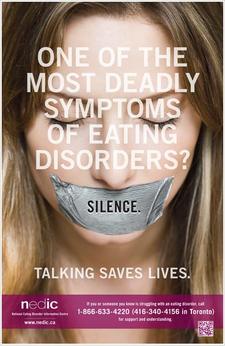
Recommended For:
Those interested in child and adolescent psychiatry, pediatrics, or family medicine, as well as families who have a child diagnosed with an ED.
 Eating Disorders in Childhood and Adolescence, is a great resource designed to provide readers with insight into both a young patient and parent's perspective on experiencing eating disorders (ED). In addition, it outlines psychological assessments and physical assessments, both of which are incredibly important aspects of interviews with these patients, and describes how the brain functions in a child or teen with an ED. Lastly, it highlights and provides research into the various therapies available, as well as the basic management approach including nutrition and re-feeding. Recommended For: Those interested in child and adolescent psychiatry, pediatrics, or family medicine, as well as families who have a child diagnosed with an ED.
0 Comments
 As one of the recent posters from the National Eating Disorders Information Centre says, for eating disorders like most mental health issues, silence can be deadly. Rather, it's talking that helps to save lives. Canadian and young eating disorders advocate, Emily Doer, knows all too well just how difficult and isolating it can be to have an eating disorder like anorexia and/or bulimia. However, despite the stigma and the lack of open and candid conversation and discussion about eating disorders, Emily began sharing her personal story about her struggles with an eating disorder. Not only was she displaying immense strength and courage, but she was putting the NEDIC's message into action, by encouraging others to talk ... and to listen. As Emily says in her TED talk below, "by sharing these experiences with one another, it can not only help to heal us, but it can help other people along the way. It's about forgiving yourself enough to be open, and letting others in so that they can learn from your experiences." "After a three-year struggle with anorexia nervosa and bulimia nervosa, Emily Doer was voluntarily admitted to the Adult Eating Disorders Program at the Health Sciences Centre in Winnipeg for treatment in April 2011. One of her motivations for recovery was returning to school to complete the final two years of a communications degree, which she will graduate with in spring 2013. She is the founder and organizer of "Tea for ED" a tea party fundraiser for adult eating disorders, an event which started as a school project and has blossomed into an awareness campaign. She shares her personal experiences with her eating disorder and recovery to help reduce the stigma and shame of this disease, and in hopes that others suffering in silence know that they are not alone (tedxtalks.ted.com)" For more information on Emily Doer's story:
Curious to know more about the science and psychology behind eating disorders like anorexia? If so, watch Dr. Laura Hill's informative TED talk in which she helps explain what those with eating disorders feel and experience using data from fMRI studies, and discusses the future direction for treatments. "Calm, pleasure and satisfaction is what most people experience after eating. But for people with eating disorders, food brings anxiety, disturbance and noise. Dr. Hill takes a look from the inside out from the "sound" to the biology of these diseases and how the future holds a different approach to manage the illness while bringing these patients hope" (tedxtalks.ted.com).  The National Eating Disorder Information Centre, reports that among Canada's young women (aged 15-24) in 2002, the prevalence of eating disorders was 1.5%. They also report, based on findings from clinical studies, that the lifetime prevalence of anorexia, bulimia and binge-eating disorder are somewhat "low" (<5%). However, in 2013 an article from CTV News expressed concern about rising rates of eating disorders among adults, adolescents, and children, some even as young as 5 years old. What's more is that the Government of Saskatchewan has shared some scary but eye-opening information about EDs including that 85% of women are dissatisfied with their bodies, and 15-20% of Canadian women exhibit symptoms of EDs. While EDs are common among women, they are not restricted to just one gender. In fact, not only is it thought that the prevalence of EDs among males is rising, studies have found that 40% of adolescent boys are dissatisfied with their bodies, and many males with EDs seek help for treating the symptoms of their disorder but not for the disorder itself. From all of the statistics and studies on EDs one thing is clear: many people are suffering from potentially life-threatening EDs, and too many are suffering in silence. So how can we help reduce the number of those struggling with EDs? One way would be to better understand EDs, so that we may better identify these patients, help connect them with treatments, and support them through recovery. As the causes of and risk factors for EDs tend to be numerous and multifactorial, in addition to varying from patient to patient, one of the best ways to familiarize yourself with EDs is likely through increased exposure. That being said, below you will find a small collection of written stories and blog posts, as well as a few videos that allow you to gain deeper insight into the background stories and experiences of those with AN, BN, and BED. For a brief overview of the different types of EDs, the causes and risk factors, treatment options and incidence, check out the infographic below from HealthResearchFunding.org!
Hogewey is a small protected village just outside of Amsterdam, and is the first of its kind in the world. At Hogewey, every resident has severe dementia, but what makes it stand out is the unique and innovative ways in which care is provided. Unlike other nursing homes or seniors' residences you've heard about or seen before, Hogewey focuses on valuing their patients as people first, maintaining dignity and mobility of their residents, but most especially on preserving a sense of and the experiences of normal life. There is a lot to be learned from this brilliant "dementia village" ... To get a first hand glimpse into Hogewey, meet some of the amazing staff as well as the residents who live there, gain some advice on interacting with those who have dementia, and learn about the significant impacts this type of care home is having on these patients, check out the CNN video below. You can also read more about Hogewey here:
Doctors are not immune to illness, even mental illness. With 1 in 5 people being affected by mental health issues, it is very likely we will come to know a colleague in healthcare (perhaps it will even be us) who will suffer emotionally or psychologically. In "Doctors Go Mad Too", psychiatrist Dr. Claire Polkinghorn, describes her transition from doctor to patient and sheds some light on her experience as a patient with mental illness, including the initial denial despite warning signs, the stigma she faced from acquaintances and other physicians after being diagnosed, and most importantly she shares the things she learned that only those who have walked a mile in the shoes of a patient would know.
Dementia Behind Bars is a must-watch short documentary that details the rising rate of dementia in prison and explains that those behind bars are often at heightened risk for diseases and mental health issues such as dementia. More than that though, the documentary highlights how these individuals are usually not able to be released to nursing homes, and that the prisons which are are often understaffed as it is, cannot afford trained caregivers for these inmates who become unable to feed, dress, or clean themselves. As a result, prisons have resorted to one last option ... training other inmates to act as caregivers for those with dementia. For the associated article, visit:
Did you know ... there are service dogs for veterans and others suffering from PTSD? In fact, in the US, PetSmart has recently started an initiative called PetSmart for Patriots which helps make service dogs more widely available to any veteran. While it is well known that service dogs can help those with physical disabilities complete their activities of daily living, these pups also help those suffering from symptoms of PTSD and anxiety. Specifically, there was a study conducted through the Psychiatric Service Dog Society which found that over 80% of those with PTSD reported a reduction in their symptoms since becoming an owner of a service dog, and around 40% were able to reduce their medications. As you can find out more from the links below, service dogs for those with mental health issues such as PTSD are trained to monitor an individual's behaviour, recognize when they become anxious, and physically redirect them and instill a sense of calm through nudges and licking. In addition, many individuals with PTSD are hypervigilant which causes tremendous tension and anxiety. In this way dogs help to suppress the hyper vigilance by ensuring the individual is protected and has their needed personal space, but also through petting the dog and the constant companionship they provide panic and paranoia can be reduced, and one can stay in the moment. For more information, check out:
|
Description
Supporting and enhancing students' and health professionals' knowledge and understanding of mental health and psychiatry
Archives
June 2017
Categories
All
|